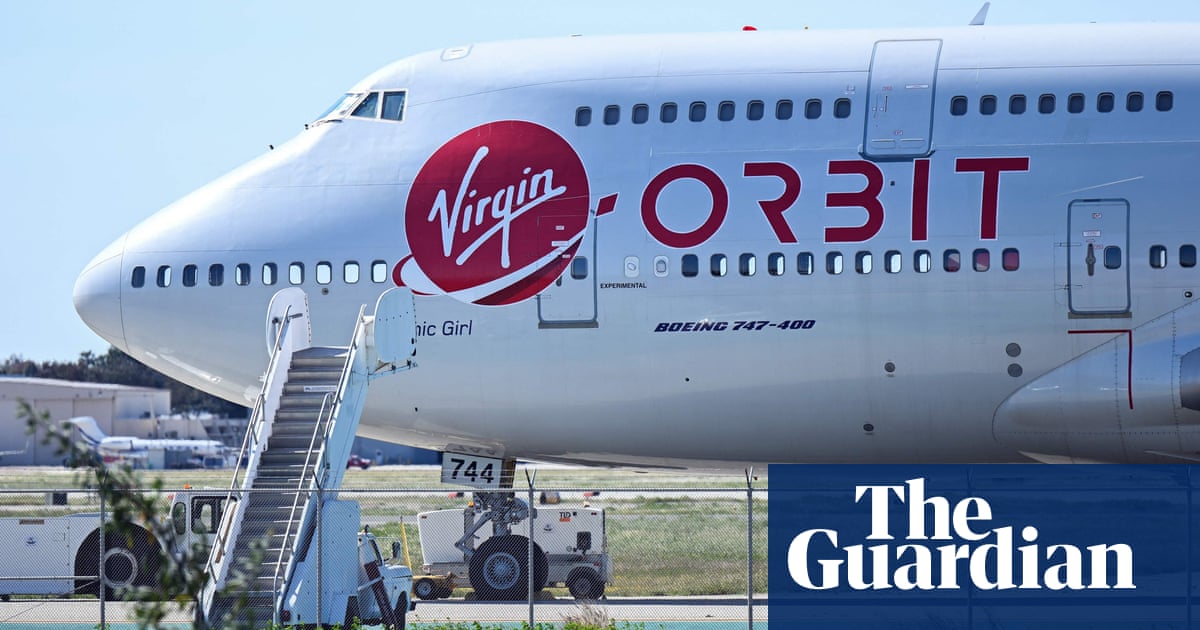
After a Virgin Orbit Boeing 747 took off from Cornwall at 10pm, carrying what would have been the first satellites to get into space from anywhere in western Europe, spectators at the launch site outside Newquay did a conga.
The rocket carrying the satellites was released at 35,000 feet an hour later – and briefly made it into space. But then came “an anomaly that has prevented us from reaching orbit”, and mission failure. Now UK air accident investigators are trying to work out what went wrong.
But Cornwall is not the only site in the UK getting into the space race. The Shetland Islands boast 150,000 sheep, close to 25,000 people, and one half-finished spaceport. When a retired RAF flight lieutenant proposed repurposing a former airbase as a satellite launch site on the island of Unst in 2017, the community council thought it was an April fool’s joke; six years later, it has a completed launch pad and hopes to send rockets into orbit this year.
“The pace of change in this business is incredible,” said Scott Hammond, deputy CEO and operations director of SaxaVord Spaceport UK. He was speaking from an office a few kilometres from the Unst launch site. “Ten years ago, it was a dream. But as we move towards it being a reality, the excitement builds.”
While Shetland and Cornwall, along with a site in Sutherland, are the most advanced, further spaceports are under construction in Argyll, Prestwick, Snowdonia and the Outer Hebrides. The UK Space Agency estimates that the wider industry generated £16.5bn in income in 2019/20 and employs about 47,000 people.
So how did space get so massive – and how much of a setback is Monday’s failure?
What went wrong with the Cornwall launch?
That is still under investigation – but Virgin Orbit said the problems occurred “during the firing of the rocket’s second stage engine”. The company said that it had failed to reach the 17,000 mph it needed to gain the correct altitude and said that one possibility is that it was slowed down because the rocket’s casing did not fall away as it should have.
This isn’t a total shock: documents submitted (PDF) to the Civil Aviation Authority before the launch estimated the chance of failure at 27%. Matt Archer, the director of commercial space flight at the UK Space Agency, said that there had been tears when the news came through, but added: “We achieved a launch. A lot of positives have been achieved. Space is hard.”
“It’s easy to feel down about it,” Hammond said. “But failure is part of the business. However much computer testing you do, until you light the blue touchpaper, you never really know. And you often learn more from failure than success. They didn’t get satellites into orbit, but I think they’ve achieved 90% of their tick list.” The markets took a less philosophical view: Virgin Orbit’s shares finished 14% down on the Nasdaq stock exchange.
Why does it matter?
Way back in 2021 before Grant Shapps erased him from a publicity photo, Boris Johnson declared his aim of creating a “Galactic Britain”. You may view this as empty cheerleading – and going to space might seem a fairly marginal concern in a time of deepening earthbound crises. But Hammond insists that there is vast commercial potential. “The global appetite for space data is incredible,” he said. “And the UK is very well placed to capitalise on it.”
This isn’t about Apollo-style tilts at the moon, but more modest low-orbit commercial launches of small satellites, which have applications from high-speed broadband to climate monitoring. The UK already has significant expertise in their manufacture – which accounts for the size of the industry already.
Once they are built, though, they are shipped abroad – and there is not a single working launch site anywhere in Europe. “We have clients from Germany, France, Turkey – this isn’t just about British satellites,” Hammond said. “The UK is in an ideal position to get that business.”
Why the UK?
Other European countries are also trying to get into the game: Hammond mentions Norway as a particular competitor, and Sweden is also close to a launch. But because of its long coastline and island location, the UK has many potential sites without the risks that come with doing so near built-up areas.
Hammond points to another advantage at a northerly site like his: “If you’re trying to get to the moon, you want to be as near to the equator as possible, to take advantage of the Earth’s spin. If you want to get into polar orbit [that is, travelling past the Earth from north to south] you want the opposite.” That means less fuel, and more payload – and with customers paying a ballpark $10,000 per kg aboard a rocket, that is enormously valuable over time.
Why did I see a jumbo jet instead of a rocket take off in Cornwall?
There are two fairly self-explanatory launch types: horizontal and vertical. Horizontal launches like the one in Cornwall see a jet take a rocket off the ground before releasing it in the upper atmosphere. Vertical launches just go straight up without the assistance of an aeroplane. (See the mock-up of a launch at the Shetland site above.)
The Cornwall site is in the minority – about 90% of launches are vertical – but it has advantages: each launch uses less fuel, and it’s easier to set up a site at an existing airport. “They also say weather has less impact,” said Hammond. “But the big thing with vertical launches is that they’re much better understood, you know what satellites need to be able to withstand.” Of course, as he also cheerfully notes, he’s biased.
What happens next?
If you’re hoping that the answer to this is your own shot at space tourism, you may be disappointed: while there are occasional noises about sub-orbital trips for paying customers in the UK, it’s likely to remain the preserve of the not-totally-relatable likes of Jeff Bezos, Richard Branson and Elon Musk for a while yet.
Hammond is sufficiently excited about the satellite business to make up for it. “There’s so much potential,” he says. “Two thousand people went to see a 747 get airborne in Cornwall – but it’s not quite as sexy as a rocket going up, is it?” The Shetlands are quite a remote spot for casual observers, I say, but he is undeterred. “When people go to Florida they go to Cape Canaveral – we fully expect to have people coming here.”
“I would love it to get to the point where the 9.30 launch from Shetland is just as normal as the 9.30 flight from Heathrow to New York,” he added. “100 years ago, it would have been unbelievable - now it’s just mundane. That’s where we want to get to.”












